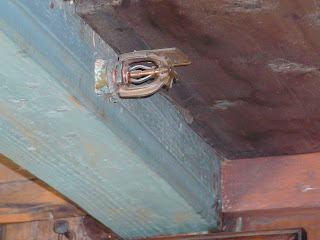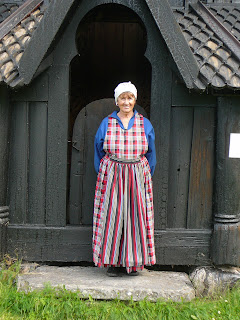Photographed in 2010
The stave church is located in the center of
Lom and is still a parish church, dedicated to the Virgin Mary, St. Olav and John the Baptist. The high steeple can be
seen from every point in the town.
Lom is situated in Gudbrandsdal
Valley , which is Norway
In the 17th century, a horizontal
log-built addition was added. Shortly after that, the church again underwent
alteration and was converted to a cruciform shape. At some point, the
ambulatory (covered walkway around the church) was removed.
At the same time that the church was converted
to a cruciform shape, the tower with tall, thin spires was added.
In the 20th century, it was
discovered that a roof ridge top with a dragon head and a cross dated from the
original church construction in the 12th century. Since it was the
only such roof decoration still remaining, it was decided to remove it and
place it in the Folk Museum in Lillehammer
This is an original portal from the 12th
century and is now located on the north transept.
In contrast to many stave churches, much is known
about the early period of this church because of an unusual amount of historical
documentation pertaining to the church. Lom, originally built as a Catholic
church as were all stave churches, was richly decorated during the medieval
period with religious art, textiles and silver objects. During the Reformation,
out went artwork, sacred vessels, triptychs, etc. Some were thrown into the
river – others were stolen. For many years, the church interior was quite
bleak.
However, by the 1600s church decoration began
to reappear. Painted decorations on the walls of the nave and ceiling of the
choir appeared as early as 1608 (a scene of Christ’s baptism was painted on the
choir ceiling that year). Local inhabitants donated funds to pay for these
decorations. Paintings by Eggert Munch were added in the early 1700s. An
elaborately carved pulpit and chancel arch were installed in 1793. The pews are
painted Norwegian blue.
The lighting in the interior of Lom is lovely
(on a sunny day). Most stave churches are quite dark or else they have added
windows that are not very well placed or maybe too big and the sun tends to
glare in to the point of blinding / obstructing one’s view of certain parts of
the interior. Here, the windows seem to be extremely well placed and the sun
kind of flows in with a warm glow.
During the 1940 Norwegian Campaign, Germans
prisoners of war were held in a camp in Lom. The town was bombed twice by the
Luftwaffee in April 1940.





































